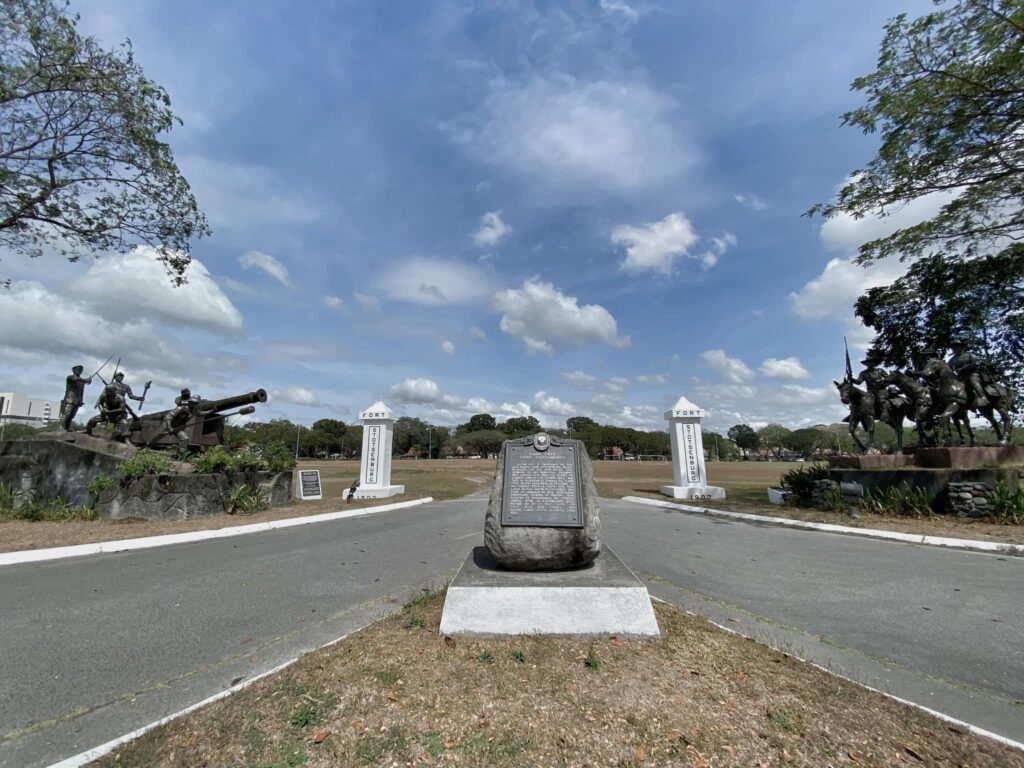
I took these photos at the Parade Ground of the old Stotsenburg. Historical markers are established by the NHCP, and the 13th Air Force to highlight the events of the founding of the American camp that used to be an Ayta settlement and the original pillars. Fort Stotsenburg however, the name was actually in used even before the establishment of the Fort near Sapang Bato in Angeles City. Official US Army reports from Annual Report of the War Department ending June 1900 cited an American army facility Camp Stotsenburg at the height of the Philippine-American War in 1899 not at the present Parade Ground but in Manila, one of the several camps established by the Americans during the early stage of the war.
Who was possibly the first high ranking American officer to enter what is now the premises of Fort Stotsenburg? Nope, it was not in 1900, or in the succeeding years 1901 or 1902, when elements of the 5th Cavalry went further northwest from main encampment in Angeles looking grazing fields for the horses, or to check any Filipino remnants of the Army of Liberation that turned into smaller bands of guerrillas in the aftermath of General Aguinaldo’s Bayambang Declaration in November 13, 1899.
It was actually Colonel J. Franklin Bell of the 36th Infantry US Volunteers. Col. Bell received an order from General Arthur MacArthur in command of the 2nd Division (based in Angeles) on November 7, 1899 to conduct northern advance to Mabalacat via the Porac-Mabalacat mountain trails. The main body of General MacArthur would strike along the railroad line in the front on November 8 against Filipino defenders north of the Abacan River and into Mabalacat.

There were no encounter, engagement or battle that had taken place at the site of the Fort Stotsenburg, particularly at the vicinity of the Parade Ground. The fighting at the time in October 1899 was concentrated on the Abacan River front, where the American 2nd Division was occupying Angeles, sought of the riverbanks, while to the north, the Filipino forces under the brigade of General Luciano San Miguel were positioned. When the general movement of the American division along the railroad line begun on the morning of November 8, 1899, the San Miguel Brigade already retreated further north and finding the Filipino trenches around Balibago and Malabanas, empty.

Col. Bell, with a baby Hotchkiss 1.65-inch mountain gun along with his 3 battalions and detached elements of the 4th U.S. Cavalry, were stationed in Porac in the aftermath of the Second Battle of Porac on November 2, 1899. In compliance with the order, the outfit started the march along the mountain trails in Porac Mountains and did not encounter any substantial Filipino forces along the way in Dolores, Banaba, Pasbul and Palumput settlements. After taking the route of the mountain trails, the command reached barrio Pulasapis, and just a few kilometers further north, Sapang Bato was located.
After finding no opposition in Pulasapis, the American 36th U.S. Infantry (Volunteers) continued its advance west of Mabalacat, in the area of the Stotsenburg and thereafter turned east until it reached the town in 6 p.m. Colonel Bell did not find any Filipino opposition or positions in that area of Stotsenburg. However, the only substantial Filipino forces were in Mabalacat to the east. About 3 companies of Filipino troops entrenched defended the outskirts of Mabalacat where they were dislodged by the American 36th U.S. Infantry (Volunteers) after a brief fight.
Colonel Bell’s regiment would settle in the old barrio of Dolores on what is now part of the Mabalacat picnic ground in preparation for the attack on Bamban Line in November 11, 1899.
The area of the Fort Stotsenburg, the Parade Ground and the west of Mabalacat would become the sphere of Filipino guerrillas under General Maximino Hizon, including Bamban Hills with Calang Mountain and Dumandin (Lumandan) as his base, until Captain McRae, 3rd U.S. Infantry, cleared the area from Banaba Hills to Calang and Dumandin in January 1900, wounding General Hizon in the battle at Dumandin.
Rhonie Dela Cruz
-Bamban WWII Museum
-Bamban Historical Society
Photos
-Images of the American cavalry.
Rhonie Dela Cruz
-Portrait of Colonel J. Franklin Bell.
Arlington National Cemetery Website



